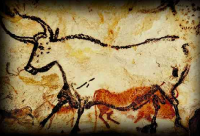First Expressions of Art –
Painting Pigments, Fiber Spinning and Felting
 Our hunter/gatherer ancestors of 32,000 years ago had to remain focused on staying alive each day. There wasn’t much time for anything else, however, evidence of primitive art has been found on cave walls in many areas of the world. The images are usually of animals and the hunt which leads archaeologists to theorize that these images were used in magic rituals to insure a successful hunt.
Our hunter/gatherer ancestors of 32,000 years ago had to remain focused on staying alive each day. There wasn’t much time for anything else, however, evidence of primitive art has been found on cave walls in many areas of the world. The images are usually of animals and the hunt which leads archaeologists to theorize that these images were used in magic rituals to insure a successful hunt.
The images were created with tools and pigments that were found locally. The tools were most probably sticks dipped into charcoal and mineral oxides such as ochre clay, hematite and manganese mixed with saliva or animal fat. The figures are remarkably well rendered and show an intimate knowledge of the subjects by the artists.
Recent discoveries from around the same time period have found evidence of the use of Flax fibers for utilitarian purposes. These fibers appear to have been twisted into crude rope and twine. Clothing consisted of animal skins and any personal adornment was probably also related to the successful hunt in the form of animal teeth, shells or bone charms.
Hmmmmm! 32,000 years ago – as artists we have a very long heritage to admire and draw from.
Communities, Husbandry and Ideas
As we gathered into community groupings, the sharing of ideas and skills began to make life a little more manage-able. The domestication of animals and the sowing of seeds made the food source more reliable leaving some time for other pursuits.
Ancestor worship required the creation of representational images and objects for offerings. The manipulation of found objects into more specialized tools and materials gave our early ancestors the ability to manipulate other found objects into useful and aesthetic elements. The notion of value applied to certain items became the currency of early trade.
The twisting of plant fibers into threads and the spinning and felting of animal hair made way for the rudimentary weaving and production of cloth. The pounding of malleable metals to create utilitarian utensils as well as artistic forms and personal adornment began the art of metalwork. Boring holes into shells, stones, bone, seeds and other found objects allowed them to be applied to garments or strung into jewelry for personal adornment and ceremony.
The use of pigmented clays and other materials mixed with a variety of specific oils made a more painterly and durable product for applying decoration to surfaces. Dwellings as well as Community buildings were decorated solely for aesthetics and not just for ceremony.

